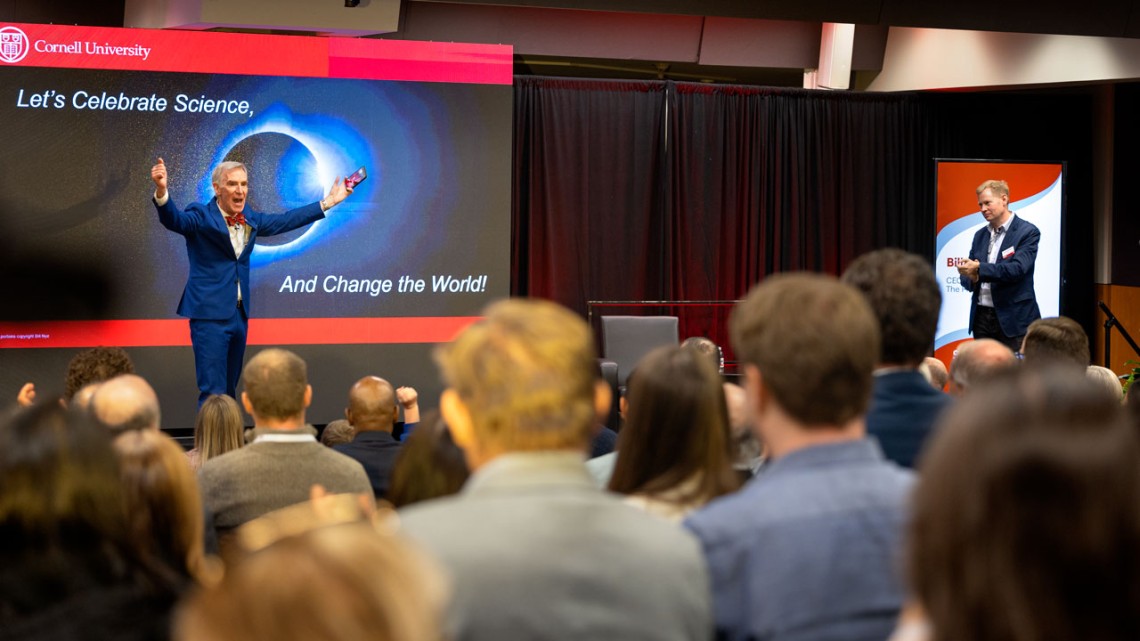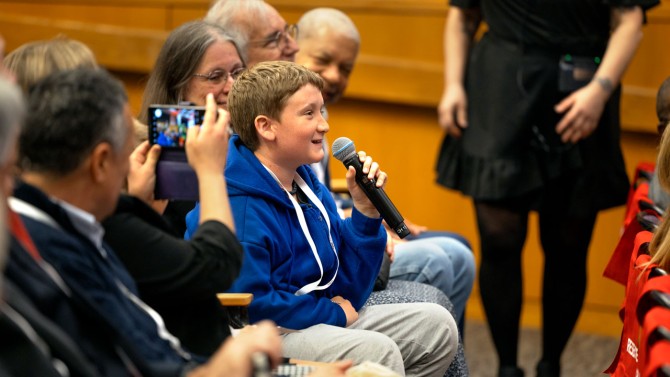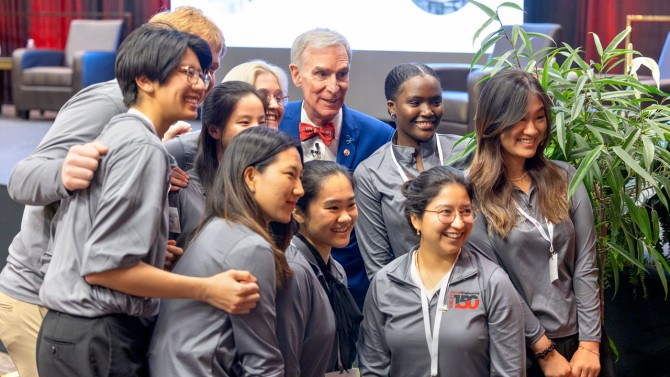
“Science Guy” Bill Nye ’77 recalled the state of mechanical engineering when he was a student and looked ahead to the field’s future at “Sibley 150,” a celebration of 150 years of mechanical engineering at Cornell.
Slide rules, sundials and comedy: Bill Nye hails scientific solutions
By David Nutt, Cornell Chronicle
The way Bill Nye ’77 tells it, he was an unpromising student admitted to Cornell due to a “some sort of clerical error” when he made a historic contribution to interstellar exploration.
As a senior, having completed his mechanical engineering requirements to the “great relief for everybody,” Nye was taking Astronomy 102 with “this famous guy, Carl Sagan.” In class, Sagan announced he was planning to include “Roll Over Beethoven” by Chuck Berry on the Voyager spacecrafts’ fabled Golden Record – but Nye insisted “Johnny B. Goode” would be the better choice.
Sure enough, that’s what is on the Voyager record.
“I take full credit for that,” Nye said, during the keynote address for “Sibley 150,” a celebration of 150 years of mechanical engineering at Cornell held April 25. “That’s why I went to engineering school, to get ‘Johnny B. Goode’ in the cosmos, so that alien entities could enjoy early rock-n-roll.”
A beloved science-education advocate and a famous guy in his own right, Nye gave a Janus-like view of the state of mechanical engineering, looking back to when he graduated in 1977 and peering ahead to the field’s future: the challenges it faces and the solutions that science offers.
Assisted by a slideshow, a few props – including a slide rule – and his giddy wit, Nye led the audience in Philips Hall on a tour of his formative experiences at Cornell and the surprising trajectory of his life after graduation. Nye recalled taking ballroom dancing for a physical education requirement, a skill that served him well, decades later, when he appeared on Dancing with the Stars – and subsequently tore his quadriceps tendon. Just as enduring has been his enthusiasm for Ultimate Frisbee. He played on Cornell’s first Ultimate team in 1973.
“I’m first to admit, everybody, Ultimate ain’t much of a name for a sport … We tried to have ‘flatball,’ but that didn’t catch on,” he said.
He spoke movingly of his professors, including Sagan and the “eccentric” Richard Phelan, M.S. ’50, who, with President Emeritus Dale Corson – “a heck of a guy” responsible for planning the Arecibo Observatory – designed the sundial on the Engineering quad.
Nye delved into his own love for, and deeply personal connection to, those old-fashioned devices. Nye’s father, Edwin Darby Nye, had relied on sundials as a prisoner of war for 44 months, and he went on to write a book, “Sundials of Maryland and Virginia,” which Nye playfully suggested would be of some use “if you’re having trouble sleeping.”
The younger Nye channeled that interest into helping design three sundials for the Mars Exploration Rover, as well as the Solar Noon Clock for Rhodes Hall.
“It’s all just part of how Cornell has affected me. The dancing, the sun dial, the clock, the Mars dials. Cornell has changed my life. Cornell has made me who I am. That’s not all good,” he said, to a burst of laughter. “I cannot thank Cornell enough for that mistake in the admissions department, and everything that’s happened since then.”
‘We can – dare I say it – change the world’
1977 was a significant year in Nye’s life, and for science. He graduated from Cornell. The Voyager spacecraft were launched. And people were already tracking the rise in global temperature that would result in the current climate crisis.
“Fifty years ago, people saw climate change coming,” he said. “And I’m hip. Young people, when you say ‘OK, Boomer, what have you done?’ Almost nothing. And so it is going to be up to you guys.”
Upon graduation, Nye took an engineering job at Boeing for $15,000 a year – nowadays students “drop $15,000 at Collegetown Bagels,” he joked. He specialized in hydraulics systems on 747s and even spent some time working on Air Force One because there was a vibration that rankled one of the pilots.
“It was the thing they give the young guy who can still do math,” he said.
However, engineering wasn’t his sole focus. While living in Seattle, Nye entered and won a regional Steve Martin lookalike contest sponsored by the comedian’s record company. (Nye lost the national competition to a man from Nashville who could play the banjo.)
“After I won this contest, people wanted me to be Steve Martin at a party or an event,” he said. “And you know, I’m not Steve Martin, because he’s really funny. But what do I have? That’s right. I’m funny looking. So I started trying to do comedy.”
Nye would work at Boeing during the day, go home and take a nap, then venture out to comedy clubs at night. Soon he was submitting jokes to a Seattle television show called Almost Live!, where he eventually debuted as “the Science Guy” – combining his knack for comedy with his passion for science.
“This was my first bit as a science guy,” the perpetually bow-tied Nye said, as he flashed an image of that early television appearance. “And you can see, I’m wearing a straight tie. It’s so weird.”
There was one emblem of the 1970s that Nye found particularly troubling: the infamous Ford Pinto, which had a reputation for exploding during rear-end collisions.
“This really bothered me as an engineer, that this was considered acceptable in the U.S.,” Nye said.
Nye launched his “Science Guy” show, which went on to win 19 Emmy Awards, to get children excited about science and solve those types of problems.
“The show is aimed at people who are 10 years old, fourth grade, because we had this very compelling research that 10 years old is about as old as you can be, to get the so-called lifelong passion for science,” he said.
As he considered the future of mechanical engineering, Nye didn’t have to look very far. He pointed across campus, to the Cornell University Borehole Observatory (CUBO).
“My CUBO, my borehole observatory: This is the future,” he said. “If we can harness the geothermal energy under North America, under everywhere, we can change the world. … And that will take artificial intelligence. But, as a guy who’s been given a platform today, this seems to me really a solvable problem. We are going to figure this out if we keep messing around with this stuff. And so I’m excited about the future.”
AI will also play a crucial role in the ongoing development of fusion energy – “Young peoples, you guys were alive when fusion worked,” he noted – as well as the increased adoption of wind and solar energy.
“This quarter, Texas made more electricity from wind and solar than it did from oil and gas. And that’s really something,” he said. “But in order to manage this, in the coming years, it’s going to take artificial intelligence. It’s going to take the young people getting computers to manage moving electricity from one place to another when the wind is not blowing and the sun is not shining.”
Nye closed by reminding everyone that the U.S. Constitution’s Article 1, Section 8 gives Congress the power to promote “the progress of science and the useful arts” – a fact that has escaped the notice of many current legislators.
“These guys in 1786, when this was finally written, realized the value of science, realized the value of understanding the world around us and understanding our place in the cosmos,” he said. “And to me, the phrase ‘useful arts’ is 18th century-speak for engineering, for using science to make stuff, bridges, church steeples, plows, whatever we were making in 1786. And that, to me is just visionary and inspirational, and kind of, if I may, astonishing. […] I feel that working together, you guys, we can use the progress of science, the engineering of stuff that moves, and we can – dare I say it – change the world.”
Media Contact
Get Cornell news delivered right to your inbox.
Subscribe


